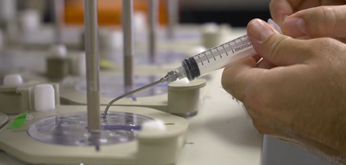.png?width=744&height=372&name=Rethinking%20Health%20%26%20Safety%20in%20NZ%20(1).png)
Let’s face it–being a safety professional can sometimes feel like you're a one-person band in a room full of people who are… let’s just say, not super enthusiastic about your tune.
You’ve got a hazard under control, and risks mitigated, but when it comes to making big changes? Yeah... it’s crickets. You try to make your case, but the next thing you know, you’re being gently (or not-so-gently) nudged to the bottom of the agenda. Ouch.
Rather than standing there holding the safety flag all by yourself, what if you could stack up your safety wins alongside other key business priorities? Sounds pretty sneaky, right? But trust me, it’s the kind of move that can actually get things done—and get them done fast.
Let’s dive into this stacking game.
So, what exactly is a stacked win?
That's a good question, but before I introduce you to a stacked win, I have to introduce you to Dr. Megan Tranter.
Last year, I had the privilege of collaborating with Dr. Megan Tranter, on an ecoPortal webinar that delved into how strategic leadership influences organisational culture, optimises risk management, and empowers teams to prioritise health and safety.
Trust me—you want to give it a watch (👉click here to watch the ecoPortal Leadership webinar).
It was in this webinar where Megan introduced us to the concept of stacked wins, and we've been fascinated with this concept ever since.
A “stacked win” is when you strategically link safety initiatives to other priorities in the business. For example, instead of simply saying, “Hey, we need to invest in better equipment to mitigate this hazard,” try linking that equipment request to a goal that’s already on the radar—like productivity improvements or reducing downtime.
Voila! You’ve just turned a safety issue into something that benefits the bottom line, and suddenly, you’re not alone.
Here’s where the magic happens: If you position safety as part of something larger, safety no longer feels like this separate entity—it’s woven into the fabric of the company’s goals.
And the best part? These stacked wins aren't just theoretical, they happen in real-life scenarios all the time, driving tangible results. Let’s explore some real-world examples where this approach has made a significant impact.
Competency and training, a match made in heaven
You might think of training as just something you “have to do” to meet compliance requirements, but in reality, it’s a fantastic way to stack safety wins while building a stronger, more capable team. When you position safety training as part of overall competency building, you're hitting two birds with one stone (no stone-throwing necessary).
Training doesn’t just teach employees how to work safely—it also gives them the skills and confidence to do their jobs more effectively. A more competent workforce means fewer mistakes, fewer accidents, and a whole lot less scrambling to fix things after the fact. Plus, it gives the team a sense of ownership over their safety, which boosts morale and engagement. But wait, there’s more: safety training also means fewer near-misses, lower accident rates, and less downtime spent dealing with preventable incidents.
Stacking these training initiatives with safety goals? Now you’ve got a recipe for a team that works better, smarter, and safer. Training doesn’t just reduce risk—it can also lead to better performance across the board. So, next time you’re pushing for more training hours, position it as a way to boost team competency and productivity, and you’ve got yourself another stacked win.
Link safety to productivity and watch the magic unfold
Now, let’s talk about the sweet spot. Safety and productivity actually go hand-in-hand—no, really. It’s not just a pipe dream. Imagine this scenario: You’re trying to push for the replacement of outdated machinery that poses a hazard. You know it’s necessary for safety, but if you focus only on that angle, it might not be enough.
But what if you stack the safety win with productivity? "Hey, upgrading this equipment will make the team more efficient, reduce breakdowns, and allow us to meet production targets faster." Now you’ve got not one, but two birds with one stone—and everyone’s listening. The head of engineering? Totally on board. The operations manager? They’re high-fiving you. And suddenly, safety becomes something they want to address.
There’s no I in team…
One of the most powerful aspects of stacking safety wins is that it turns your initiative into a team effort. As a safety professional, you’re probably used to that feeling of walking into a meeting where you’re the lone voice advocating for risk mitigation, while everyone else seems focused on their own priorities. It can feel like you’re shouting into a void. But when you align safety with what other departments care about—whether it’s cutting costs, improving efficiency, or fulfilling union demands—you start to create allies in all the right places.
Instead of standing alone, you’re now part of a bigger conversation. Operations need to hit production goals? You’ve got the safety angle covered. Engineering needs to reduce machine downtime? That new equipment you’ve been asking for is the answer. HR wants to increase employee engagement? Training initiatives are a win-win. Safety isn’t just your problem anymore—it’s part of the solution that everyone’s working toward.
So, the next time you’re faced with a safety challenge and find yourself thinking, “It’s just me against the world,” remember this: as a leader, you have the power to influence change across every corner of the business. The key lies in strategically aligning safety with broader business objectives, demonstrating its critical impact on both culture and performance. It’s not just about preventing accidents—it’s about driving results and building a resilient, engaged workforce. By strategically engaging key stakeholders and making safety a core business priority, you set the foundation for long-term success.
Final words
Stacking safety wins isn’t merely a tactical play—it’s a transformational leadership approach. By embedding safety into the fabric of your organisation’s strategic goals, you can shift safety from a siloed concern to a shared responsibility that resonates throughout the entire business. As a leader, this is about working smarter, not harder—fostering a culture where safety is inherently understood as an integral part of sustained growth. When you lead the charge in making safety a top-line priority, the impact is undeniable, and the results speak for themselves. Drive alignment, inspire your team, and watch as safety becomes not just a goal, but a redefining pillar of your business success.
-3.png?width=400&height=400&name=image%20(1)-3.png)






